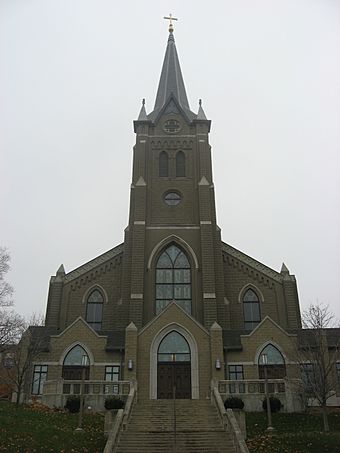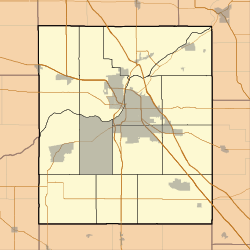St. Mary Historic District (Lafayette, Indiana) facts for kids
Quick facts for kids |
|
|
St. Mary Historic District
|
|

Cathedral of Saint Mary of the Immaculate Conception, November 2009
|
|
| Location | Roughly bounded by Main, South, 10th and 14th Sts., Lafayette, Indiana |
|---|---|
| Area | 358 acres (145 ha) |
| Built | 1950-1974, 1925-1949, 1900-1924, 1875-1899, 1850-1874, 1825-1849 |
| Architect | Multiple |
| Architectural style | Italianate, Greek Revival |
| NRHP reference No. | 01000622 |
| Added to NRHP | 2001 |
The St. Mary Historic District is a special area in Lafayette, Indiana. It's recognized as a national historic district because of its important old buildings and rich history.
This neighborhood became a lively place after St. Mary's Catholic Church moved to Columbia Street in 1864. Many church members also moved nearby, making the church a central spot for both religious life and community gatherings.
The district is famous for its beautiful homes, many built in the 1860s and 1870s. You can see different architectural styles here, like Italianate, Greek Revival, and Queen Anne. Most of the people who built these grand houses were successful business owners from Lafayette. For example, James Ball, a local grocer, even stamped his name into the front steps of his home at 1202 Columbia Street!
Across the street is the James H. Ward House. James Ward and his brother owned a popular carpet and wallpaper store in town. Another interesting resident was James Murdock, who moved to Columbia Street around 1891. He used to be a prison warden and later ran a grocery business and worked in bridge construction. His home was later sold to Ferdinand Dryfus, who, with his brother, ran a meat packing company.
Contents
What Makes Buildings Special?
When a building is part of a historic district, it's given a special rating. This rating helps us understand how important it is.
- "Outstanding" (O) means a building is very important. It has enough history or special design to possibly be listed on its own in the National Register of Historic Places.
- "Notable" (N) means a building is above average. With more study, it might also be important enough for its own listing.
- "Contributing" means a building fits the basic rules for the district. While it might not be special on its own, it helps make the historic district unique when combined with other similar buildings.
Famous Buildings in the District
Many buildings in the St. Mary Historic District have interesting stories. Here are some of the most well-known ones:
Columbia Street Homes
- 1104 Columbia Street: This is the Dr. George Beasley House, built in 1902. It's a great example of the Colonial Revival style. (O)
- 1116 Columbia Street: The James H. Ward House, built in 1860, shows off the Italianate style. (O)
- 1207 Columbia Street: This is the impressive Cathedral of Saint Mary of the Immaculate Conception. It was built in 1864 in the Gothic Revival style. (O)
- 1211 Columbia Street: The Joseph Shearn House, built around 1870, is another Italianate style home. (N)
- 1214 Columbia Street: The James Ball House, built in 1862, combines Gable-front, Greek Revival, and Italianate styles. (O)
- 1307 Columbia Street: The James Murdock House, built around 1890, is a beautiful Queen Anne style home. (N)
- 1304 Columbia Street: The Robert Davidson House, built around 1910, is an American Four-Square style house. (N)
- 1311 Columbia Street: The Laura and Philomene Wabner House, built around 1895, is in the Colonial Revival style. (N)
- 1318 Columbia Street: The Francis Duffy House, built in 1868, is an Italianate style home. (O)
- 1321 Columbia Street: This house, built around 1890, is a Queen Anne style home. (N)
- 1402 Columbia Street: This house, built around 1880, is in the Italianate style. (N)
- 1413 Columbia Street: This house, built around 1870, is another Italianate style home. (N)
- 1417 Columbia Street: This house, built around 1870, also features the Italianate style. (N)
Main Street Homes
- 1501 Main Street: This house, built around 1880, has a Gable-front style. (N)
Images for kids






